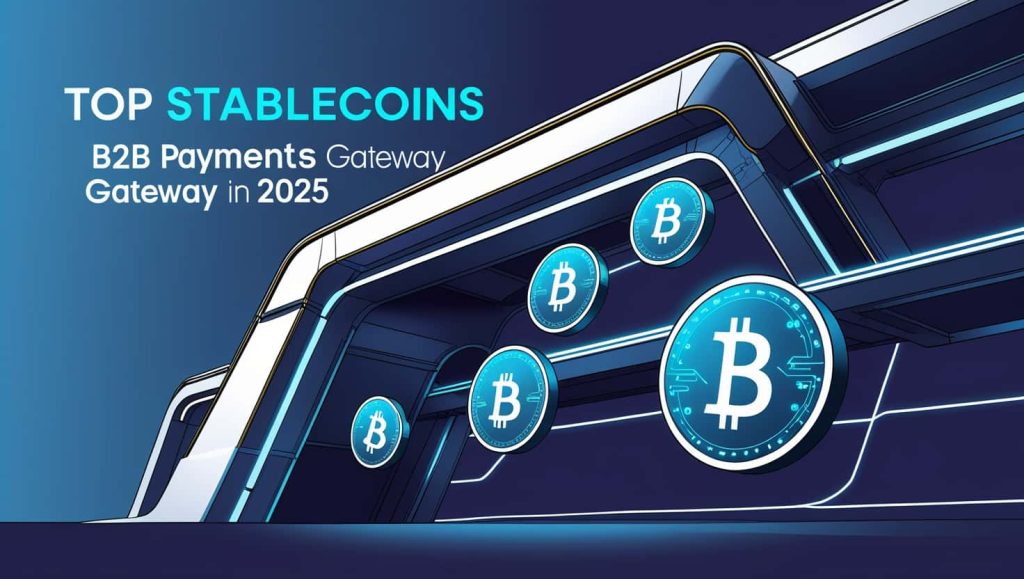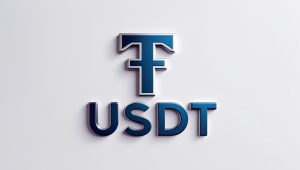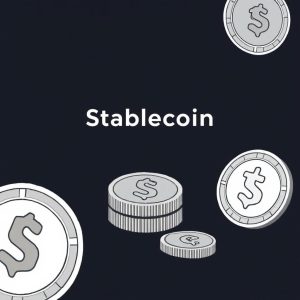In an increasingly interconnected global economy, businesses demand fast, secure, and cost-effective payment solutions. Traditional cross-border payment systems are often slow, expensive, and complex — creating barriers for modern enterprises. Enter stablecoins: blockchain-based digital currencies designed to maintain a stable value, now revolutionizing B2B payments with faster transactions, lower fees, and enhanced transparency.
By early 2025, the stablecoin market is booming, with over 27.5 million active users, according to the latest Visa reports. Enterprise adoption is surging, with global giants like SAP piloting stablecoin-powered cross-border payments. Payment processors now report that stablecoins represent nearly 60% of all crypto transaction volume, solidifying their role in modern financial infrastructure.
In this definitive guide, we’ll explore the best stablecoins for B2B payments in 2025, their key benefits, challenges to consider, and actionable insights on how your business can integrate them to streamline operations, reduce costs, and stay ahead in the digital economy.
What Are Stablecoins — And Why Are They Perfect for B2B Payments?
Stablecoins are a special type of cryptocurrency designed to maintain a consistent value by being pegged to stable assets like fiat currencies (USD, EUR) or commodities (such as gold). By combining the speed and transparency of blockchain technology with the predictability of traditional money, stablecoins have become an ideal solution for business-to-business (B2B) payments.
How Stablecoins Work: 4 Key Models
Stablecoins achieve price stability through different collateralization methods:
-
Fiat-Backed Stablecoins
These are backed 1:1 by traditional currency reserves (e.g., USD) held in regulated banks or custodial accounts. This is the most common and widely trusted model. -
Commodity-Backed Stablecoins
Pegged to physical assets like gold or silver, these stablecoins derive value from tangible commodities, providing an additional layer of trust and security. -
Crypto-Collateralized Stablecoins
Backed by cryptocurrencies, these rely on smart contracts and are typically over-collateralized to absorb price fluctuations of the underlying assets. -
Algorithmic Stablecoins
These use supply-and-demand algorithms to automatically stabilize value — without any collateral — making them innovative, but riskier, in certain market conditions.
Why Stablecoins Are the Future of B2B Payments
Businesses around the world are rapidly adopting stablecoins for cross-border and high-volume transactions — and for good reason:
-
✅ Price Stability: Avoid the volatility common with Bitcoin or Ethereum. Stablecoins maintain a consistent value, reducing financial risk in business transactions.
-
⏱️ Faster Settlements: Transactions are processed in minutes — not days — helping businesses improve cash flow and operational efficiency.
-
💸 Lower Fees: Most stablecoin transactions cost less than $1, a fraction of what traditional banking and SWIFT systems charge.
-
🌍 Global Reach: Send and receive payments internationally without worrying about currency exchange, banking hours, or intermediaries.
-
🧠 Programmable Payments: Use smart contracts to automate workflows, trigger conditional payments, or integrate escrow mechanisms seamlessly.
-
🕒 24/7 Availability: Unlike traditional banks, stablecoin networks are always on, supporting instant, around-the-clock transactions.
Operate in Forex? Our Tether payment infrastructure is optimized for fast, secure settlements and seamless API integration.
Top Stablecoins for B2B Payments Gateway
| # | Name (Ticker) | Type | Peg | Market Cap (Q1 2025) | Ideal For | Key Consideration |
|---|---|---|---|---|---|---|
| 1 | Tether (USDT) | Fiat-collateralized | USD | $112B+ | High-volume, global B2B settlements | Transparency controversies |
| 2 | USD Coin (USDC) | Fiat-collateralized | USD | $32B+ | Regulated industries, compliance | Slightly higher fees |
| 3 | DAI | Crypto-collateralized (decentralized) | USD | $5.3B+ | DeFi-native B2B use, automation | Complex collateral model |
| 4 | Binance USD (BUSD) | Fiat-collateralized | USD | $70M+ | Binance-centric businesses | No new issuance |
| 5 | TrueUSD (TUSD) | Fiat-collateralized | USD | $494M+ | Transparency-focused firms | Lower liquidity ecosystem |
| 6 | Frax (FRAX) | Fractional-algorithmic | USD | $1B+ | Cost-efficient businesses open to innovation | Dynamic collateral model risk |
| 7 | Pax Dollar (USDP) | Fiat-collateralized | USD | $940M+ | Regulated, audit-driven B2B use | Lower market share |
| 8 | USDD | Over-collateralized crypto-backed | USD | $739M+ | TRON ecosystem-based B2B flows | Algorithmic stability concerns |
| 9 | Gemini Dollar (GUSD) | Fiat-collateralized | USD | $565M+ | Highly regulated operations | Limited exchange presence |
| 10 | Pax Gold (PAXG) | Commodity-backed | Gold | $482M+ | Gold-hedged treasury or asset-backed payments | Gold price volatility |
| 11 | Tether Gold (XAUT) | Commodity-backed | Gold | $474M+ | B2B hedge against inflation, gold-pegged transfers | Less liquidity than fiat-pegged coins |
As stablecoins continue to reshape the future of financial transactions, choosing the right one for your business is critical. Based on market capitalization, adoption, liquidity, and enterprise-grade features, here are the top stablecoins for B2B payments in 2025:
1. Tether (USDT)
Market Cap: $112+ billion (Q1 2025)
Tether remains the largest and most widely used stablecoin in the world. Pegged to the US dollar, USDT is favored by businesses for its deep liquidity, wide exchange support, and multi-chain compatibility.
Key Benefits:
-
🌐 Global Acceptance: Listed on 400+ crypto exchanges and supported by Ethereum, Tron, Solana, Algorand, and more
-
💧 High Liquidity: Market-leading trading volume ensures low slippage and fast conversions
-
🔁 Cross-Chain Flexibility: Choose the network that best suits your cost and speed requirements
Best for: High-volume international B2B transactions and businesses needing extensive exchange integration.
Consideration: While Tether has faced scrutiny over reserve transparency in the past, it now provides regular attestations and has maintained its peg consistently.
2. USD Coin (USDC)
Market Cap: $32+ billion (Q1 2025)
Backed by Circle and Coinbase, USDC is known as the most regulator-friendly and transparent stablecoin — making it a favorite for compliance-conscious businesses.
Key Benefits:
-
🛡️ Monthly Audits: Third-party attestation of 1:1 USD backing
-
✅ Regulatory Compliance: Built with U.S. and global financial regulations in mind
-
👔 Enterprise Features: Robust support for business accounts and compliance tools
-
🔗 Multi-Chain Access: Operates across Ethereum, Solana, Algorand, and more
Best for: Regulated industries and businesses prioritizing legal compliance and transparent operations.
Consideration: USDC may have slightly higher fees on some blockchains, but it remains cost-effective for most B2B use cases.
3. DAI (DAI)
Market Cap: $5.3+ billion (Q1 2025)
DAI stands out as a decentralized, crypto-collateralized stablecoin operated by the MakerDAO community. It offers autonomy, transparency, and full on-chain visibility.
Key Benefits:
-
🏛️ Decentralized Governance: No central authority — decisions are made by token holders
-
🔐 On-Chain Transparency: Collateral is visible and verifiable 24/7
-
🧠 DeFi Compatibility: Easily integrates with smart contracts and decentralized platforms
-
🏗️ Resilience Mechanisms: Over-collateralized design helps maintain peg during volatility
Best for: Tech-savvy businesses focused on DeFi integration and decentralization.
Consideration: May involve a learning curve for companies new to crypto, especially due to its complex collateral model.
👉 Learn More About Tether Payments Gateway for Forex
4. Binance USD (BUSD)
Market Cap: $70+ million (Q1 2025)
Although new issuance of BUSD ceased in 2023, it remains active and relevant within the Binance ecosystem, especially for businesses already using Binance for other services.
Key Benefits:
-
🏦 Regulatory Approval: Licensed by the NYDFS
-
🔄 Seamless Binance Integration: Ideal for companies trading or settling on Binance
-
💵 Full Fiat Backing: 100% USD reserves held in FDIC-insured accounts
-
📄 Transparent Audits: Regular monthly reserve attestations
Best for: Businesses operating within Binance’s infrastructure.
Consideration: While BUSD is still functional, its growth is limited due to the halt in new issuance.
5. TrueUSD (TUSD)
Market Cap: $494+ million (Q1 2025)
TrueUSD differentiates itself through a unique escrow model, real-time reserve attestations, and a strong focus on legal protections for businesses.
Key Benefits:
-
🧾 Escrow-Based Reserves: Funds held in third-party trusts for added security
-
⏱️ Real-Time Transparency: Live audits offer constant visibility into reserve status
-
🌐 Blockchain Versatility: Available on multiple networks
-
⚖️ Legal Assurance: Trust structure reduces counterparty risk
Best for: Risk-averse businesses that prioritize maximum transparency and legal safeguards.
Consideration: While secure, TUSD has a smaller ecosystem and lower liquidity compared to USDT or USDC.
6. Frax (FRAX) – The First Fractional-Algorithmic Stablecoin
Launched: March 2019
Type: Hybrid (Cryptocurrency-collateralized & Algorithmic)
Peg: US Dollar
Market Cap: $1 Billion (Rank #6)
30-Day Avg. Volume: $16.2 Million
Supported Blockchains: Ethereum, Dogechain, Avalanche, Fantom, BSC, Polygon, Arbitrum, Moonbeam
Listed On: 41+ Exchanges
Overview:
Frax is a groundbreaking fractional-algorithmic stablecoin that combines crypto collateral with an algorithmic supply mechanism to maintain its $1 USD peg. The protocol dynamically adjusts the collateral ratio based on market price—decreasing it when FRAX trades above $1 and increasing it when below. Users can mint new FRAX by depositing USDC and the protocol’s native FXS token, offering flexibility and decentralized control. Its multi-chain support and innovative design have made it one of the top stablecoins in the DeFi ecosystem.
7. Pax Dollar (USDP) – Regulated and Transparent Fiat-Backed Stablecoin
Launched: September 2018
Type: Fiat-Collateralized
Peg: US Dollar
Market Cap: $939.9 Million (Rank #7)
30-Day Avg. Volume: $377.9 Million
Supported Blockchains: Ethereum, Binance Smart Chain
Listed On: 21 Exchanges
Overview:
Pax Dollar (formerly Paxos Standard – PAX) is a fully-regulated USD-backed stablecoin, issued by Paxos, a financial institution regulated by the New York State Department of Financial Services (NYDFS). Every USDP token is backed 1:1 with real US dollars, with monthly transparency reports to verify reserves. Known for its compliance and trust, Pax Dollar is a top choice for institutions and users seeking a reliable fiat-backed stablecoin.
8. USDD (Decentralized USD) – TRON’s Over-Collateralized Stablecoin
Launched: April 2022
Type: Crypto-Collateralized & Algorithmic
Peg: US Dollar
Market Cap: $738.7 Million (Rank #8)
30-Day Avg. Volume: $15.5 Million
Supported Blockchains: TRON, Ethereum, BNB Chain
Listed On: 23 Exchanges
Overview:
USDD is a decentralized over-collateralized stablecoin developed by the TRON DAO Reserve (TDR). Backed by a diversified basket of crypto assets including BTC, USDT, USDC, and TRX, USDD maintains a collateral ratio above 200%. Through its Peg Stability Module (PSM), USDD can be exchanged 1:1 for other major stablecoins like USDT and USDC. New USDD is minted by select institutions depositing TRX, providing a secure and community-governed stablecoin alternative.
9. Gemini Dollar (GUSD) – A Stablecoin from a Regulated Crypto Exchange
Launched: September 2018
Type: Fiat-Collateralized
Peg: US Dollar
Market Cap: $564.9 Million (Rank #9)
30-Day Avg. Volume: $1 Million
Supported Blockchain: Ethereum
Listed On: 9 Exchanges
Overview:
The Gemini Dollar (GUSD) is a fully-regulated stablecoin issued by Gemini Trust Company, a U.S.-based cryptocurrency exchange. Backed 1:1 with USD and supervised by NYDFS, GUSD provides monthly attestations of its reserves through third-party audits. Trusted for its strong compliance standards, GUSD is designed for users who value transparency, regulation, and security.
10. Pax Gold (PAXG) – The Gold-Backed Stablecoin from Paxos
Launched: September 2019
Type: Commodity-Collateralized
Peg: 1 Troy Ounce of Gold
Market Cap: $482.1 Million (Rank #10)
30-Day Avg. Volume: $9.4 Million
Supported Blockchain: Ethereum
Listed On: 34 Exchanges
Overview:
Pax Gold (PAXG) is a gold-backed token issued by Paxos, where each token is pegged to one troy ounce of physical gold securely stored in Brink’s vaults in London. Holders of PAXG actually own the physical gold and can redeem their tokens for the metal itself. Regular audits and transparency reports ensure that every token in circulation is backed by real, allocated gold—offering a stable and inflation-resistant digital asset.
11. Tether Gold (XAUT) – Tether’s Gold-Backed Stablecoin
Launched: 2020
Type: Commodity-Collateralized
Peg: 1 Troy Ounce of Gold
Market Cap: $474.4 Million (Rank #11)
30-Day Avg. Volume: $6.6 Million
Supported Blockchain: Ethereum
Listed On: 15 Exchanges
Overview:
Tether Gold (XAUT) is a gold-backed stablecoin from Tether Limited, the same company behind USDT—the world’s largest stablecoin. Each XAUT token represents ownership of one troy ounce of physical gold, stored securely in Swiss vaults. XAUT combines the stability of gold with the liquidity and speed of blockchain, making it ideal for investors seeking a tokenized precious metal hedge.
Want a secure and scalable crypto payment gateway? Learn how our Tether Gateway Payment solution helps businesses process USDT transactions effortlessly.
👉 Explore the Tether Payment Gateway
Pros and Cons of Using Stablecoins for B2B Payments and Settlements
Stablecoins have rapidly emerged as a popular option for B2B payments and cross-border settlements, offering a compelling alternative to traditional banking systems. With their value pegged to fiat currencies or commodities, stablecoins bring a level of predictability that volatile cryptocurrencies often lack. However, while stablecoins offer significant advantages, they also come with their own risks and limitations.
Below, we break down the key benefits and challenges of using stablecoins for business-to-business transactions.
Benefits of Stablecoins for B2B Transactions
1. Lower Transaction Costs
Stablecoins operate on decentralized blockchain networks, cutting out the middlemen. This drastically reduces fees tied to currency conversions, remittance services, and compliance overhead. According to industry studies, cross-border remittance costs can be slashed by up to 80% with stablecoins.
For instance:
-
Transfers from Southeast Asia to Europe can be 3–4x cheaper using stablecoins than via SWIFT.
-
Transfers from Africa to Europe may cost 5–10x less.
Even when a business uses a third-party for on- and off-ramping (converting between fiat and crypto), significant savings can still be realized.
2. Faster Settlement & Improved Cash Flow
One of the biggest pain points in B2B finance is slow settlements. Cross-border payments via traditional systems often take days, with delays caused by intermediaries and foreign exchange processes.
Stablecoins remove these bottlenecks:
-
24/7 transaction capability – no banking hours required
-
Near-instant settlement times – freeing up working capital
-
Easier financial planning with faster access to funds
This ensures businesses maintain healthy cash flow and operational agility.
3. Enhanced Market Access
In regions with limited or unstable banking infrastructure, stablecoins provide a crucial alternative for businesses. They enable:
-
Sellers to reach new global markets
-
Buyers in underserved areas to access a broader range of products and services
-
Cross-border commerce without dependency on local banking systems
4. Automation Through Smart Contracts
Stablecoins often utilize smart contracts to automate payment terms. This unlocks:
-
Reduced operational costs
-
Minimized human error
-
Real-time settlements based on predefined triggers
Smart contract integrations can greatly streamline B2B invoicing, escrow services, and recurring payments.
5. Portfolio Diversification & Inflation Protection
Stablecoins can serve as a hedge against inflation, especially in volatile economies. Businesses can use them to:
-
Diversify balance sheets across different asset types
-
React quickly to market movements with greater liquidity
-
Preserve capital in high-inflation environments
This financial flexibility is especially valuable for multinational firms operating in emerging markets.
Risks and Limitations of Stablecoins for Business Use
1. Depegging Risks
While rare, stablecoins can lose their peg to the underlying asset. Some recent examples include:
-
USDC dropped to $0.87 in March 2023 after Silicon Valley Bank’s collapse.
-
Tether (USDT) briefly fell to $0.9959 during market turbulence in May 2022.
-
TerraUSD (UST) – a prominent algorithmic stablecoin – crashed entirely in May 2022.
Even minor price fluctuations can cause serious disruptions to settlement workflows and capital holdings. Algorithmic stablecoins are especially vulnerable to market panic and sell-offs.
2. Counterparty and Operational Risks
Most major stablecoins are issued by centralized entities, exposing businesses to:
-
Poor management or financial missteps
-
Cybersecurity vulnerabilities
-
Regulatory shutdowns
Case in point: Fei Protocol, a crypto-backed algorithmic stablecoin, shut down in 2022 citing regulatory and technical risks. Users had to redeem their tokens through alternate stablecoins.
To reduce exposure, businesses can:
-
Work with trusted fintech platforms like BVNK to handle stablecoin payments
-
Use stablecoins only from reputable issuers with transparent audits and strong governance
3. Regulatory Uncertainty
The global regulatory environment for stablecoins remains in flux:
-
The U.S. is considering legislation requiring all non-bank stablecoin issuers to obtain approval from the Federal Reserve.
-
The EU’s MiCA framework introduces new transparency and reserve requirements.
-
The UK’s FSMB seeks to bring stablecoin providers under existing financial rules.
Regulatory clarity is improving, but events like the FTX collapse have triggered scrutiny and calls for oversight. Some stablecoin issuers, such as Circle (USDC) and Paxos (USDP), are already enhancing reporting and reserve audits to meet rising compliance expectations.
Future Trends in Stablecoin B2B Payments
As stablecoins continue to mature, a range of emerging trends is set to shape their role in B2B payments and settlements. From regulatory clarity to blockchain interoperability, here’s what the future may hold:
1. Integration with Central Bank Digital Currencies (CBDCs)
As central banks across the globe roll out CBDCs, greater interoperability between these government-issued digital currencies and private stablecoins is expected. This fusion will streamline cross-border payments, reduce settlement times, and enhance trust in digital payment systems—especially in regulated environments. For businesses, this could mean real-time, low-cost global transactions backed by both private innovation and public trust.
2. Enhanced Regulatory Frameworks
Regulatory advancements in regions like the U.S. (e.g., the Stablecoin Bill), EU (MiCA), and UK (FSMB) are paving the way for more transparent, compliant, and resilient stablecoin ecosystems. These clearer guidelines will likely boost institutional confidence, encouraging more traditional businesses and financial institutions to adopt stablecoins for B2B payments, treasury management, and international trade.
3. Revolutionizing Supply Chain Finance
The programmable nature of stablecoins, when combined with smart contracts, is poised to transform supply chain finance. Businesses will be able to implement:
-
Automated inventory financing
-
Dynamic factoring rates based on real-time risk and inventory data
-
Multi-tier supplier payments with optimized terms
This automation will improve liquidity, reduce costs, and increase transparency across complex supply networks.
4. Cross-Chain Interoperability Standards
One major technical challenge in B2B stablecoin adoption is the fragmentation across blockchain platforms. However, new cross-chain interoperability protocols and standards (like Chainlink CCIP and LayerZero) are emerging to bridge these ecosystems. This will allow businesses to seamlessly transact across multiple blockchain networks and stablecoins, minimizing friction and increasing flexibility in financial operations.
5. Tokenization of Real-World Assets (RWA)
The intersection of stablecoins and tokenized real-world assets is unlocking powerful new financing and liquidity options. Businesses can use tokenized assets—like real estate, commodities, or invoices—as collateral or payment instruments, enabling:
-
Faster capital deployment
-
Increased liquidity for traditionally illiquid assets
-
New revenue and funding models in trade and commerce
As infrastructure around RWAs and stablecoins matures, the boundaries between traditional finance and decentralized finance (DeFi) will blur, creating hybrid solutions tailored for enterprise use.
Conclusion
Stablecoins are rapidly transforming the way businesses approach B2B payments and settlements. With benefits like lower transaction costs, faster settlement, and greater accessibility in underbanked regions, they offer a compelling alternative to traditional banking rails. However, risks such as depegging, counterparty exposure, and evolving regulatory landscapes still require careful consideration.
Looking forward, trends such as CBDC integration, smarter supply chain finance through smart contracts, cross-chain interoperability, and the tokenization of real-world assets are set to accelerate stablecoin adoption across industries. As regulations solidify and infrastructure matures, stablecoins are becoming a viable and strategic tool for modern businesses—especially in cross-border commerce and Forex trading environments.
Ready to modernize your business transactions? Discover how stablecoin-powered payments can lower costs and increase speed.
👉 Visit our Homepage













